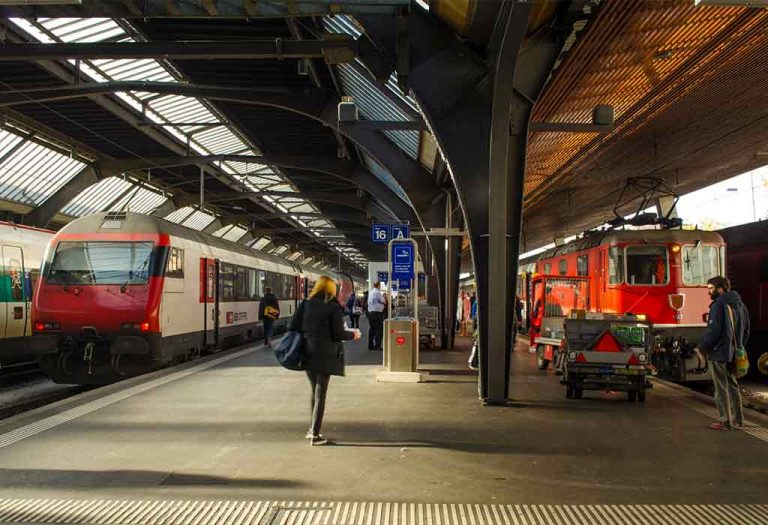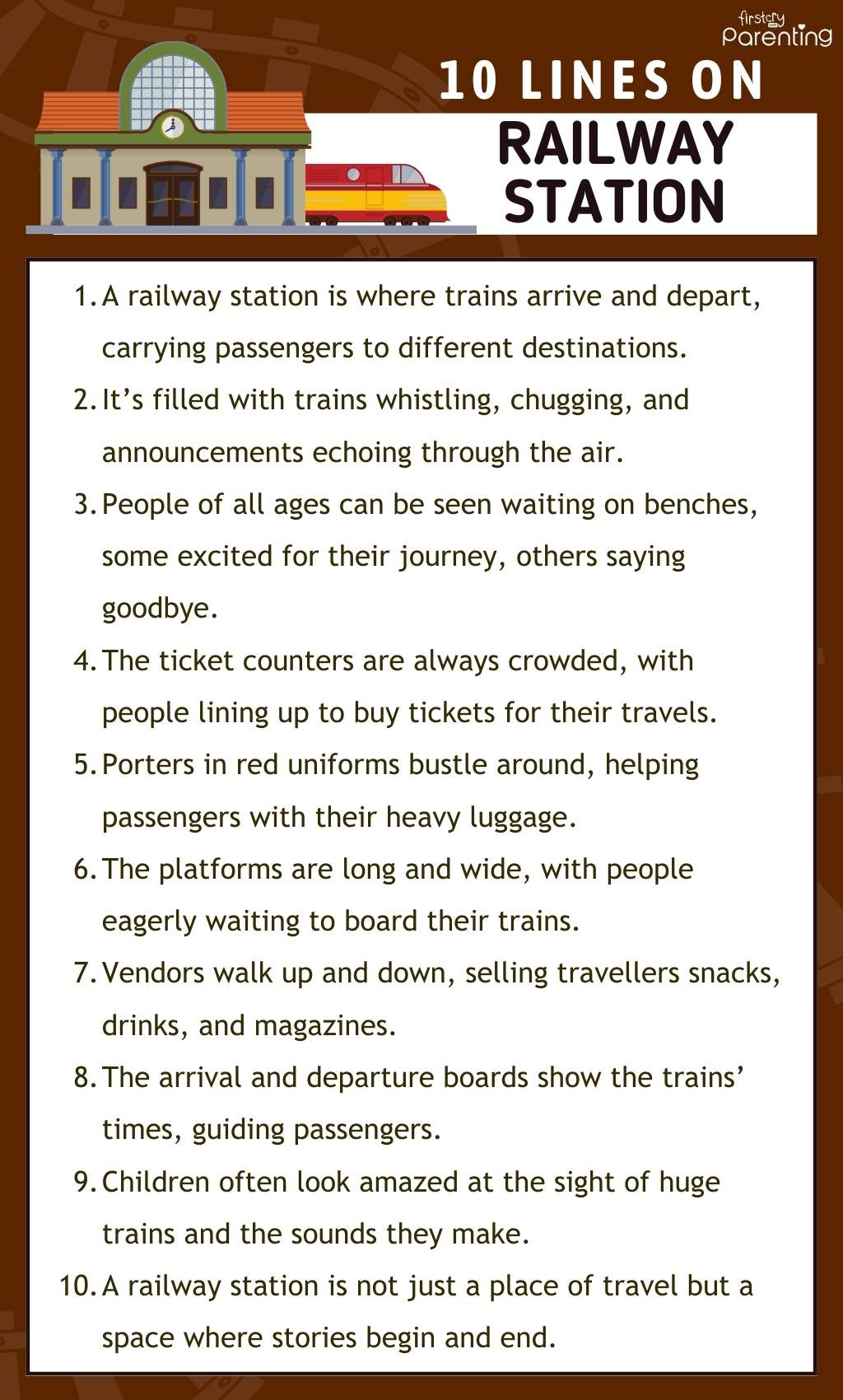Essay on Railway Station – 10 Lines, Short and Long Essay for Students and Children
A bustling railway station often comes to mind when we think of journeys, serving as the gateway to new adventures and experiences. Writing an essay on railway stations in English is not just an academic exercise; it’s a way to express our observations, experiences, and the unique atmosphere surrounding these travel hubs. Whether it’s the clatter of trains, the busy crowds, or the emotions filling the air, railway stations are a microcosm of life’s vibrant tapestry. Let’s explore the wonders of railway stations through the eyes of young minds, understanding why this railway station essay for school students and children is not just an assignment but a journey in itself.
Key Points to Remember When Writing an Essay on Railway Station
Writing an essay about a railway station is an enriching experience beyond describing a place; it’s about capturing the essence of a dynamic environment. Here are some key points to keep in mind to make your essay on a railway station engaging and vivid:
- Observe the Details: Pay attention to the small details around the station – the sounds of arriving and departing trains, the announcements, the hustle of passengers, and even the architecture. These details bring your essay to life.
- Incorporate Sensory Descriptions: Use sensory descriptions to make your readers feel at the station. Describe what you see, hear, smell, and feel.
- Share Personal Experiences or Stories: If you have personal stories or experiences related to a railway station, include them. They add a personal touch and make your essay relatable.
- Reflect on the Significance: Consider what a railway station symbolises – connections, journeys, farewells, and reunions. Reflect on these themes in your essay.
- Include Diverse Perspectives: Consider the various people at the station – travellers, workers, vendors – and what the station might mean to each of them.
- Maintain a Logical Flow: Logically organise your essay. Start with an introduction, then the main body, and conclude with your reflections or summary.
- Use Descriptive Language: Employ vivid and descriptive language to paint a picture in the reader’s mind.
- Check for Accuracy: If you mention specific details about a particular station, ensure they are accurate.
- Keep Your Audience in Mind: Tailor your language and content to suit your audience, especially if it’s meant for school students and children.
- Edit and Revise: Always revise your essay to check for grammatical errors and improve sentence structure.
10 Lines on Railway Station
A railway station is full of life and stories, a portal to various destinations and experiences. For young learners, writing a few lines on a railway station can be a delightful way to explore and describe this bustling place. Here’s a simple yet engaging 10-line essay that captures the essence of a railway station:
- A railway station is where trains arrive and depart, carrying passengers to different destinations.
- It’s filled with trains whistling, chugging, and announcements echoing through the air.
- People of all ages can be seen waiting on benches, some excited for their journey, others saying goodbye.
- The ticket counters are always crowded, with people lining up to buy tickets for their travels.
- Porters in red uniforms bustle around, helping passengers with their heavy luggage.
- The platforms are long and wide, with people eagerly waiting to board their trains.
- Vendors walk up and down, selling travellers snacks, drinks, and magazines.
- The arrival and departure boards show the trains’ times, guiding passengers.
- Children often look amazed at the sight of huge trains and the sounds they make.
- A railway station is not just a place of travel but a space where stories begin and end.
This essay for classes 1, 2, and 3 introduces the world of railway stations, offering young minds a glimpse into their dynamic and vibrant atmosphere.
Paragraph on Railway Station
A railway station is more than just a transit point; it’s a lively hub of activity and a melting pot of emotions and experiences. Here’s an essay in 100 words about the world of a railway station, which holds a unique position in our journeys and hearts.
A railway station brims with life, echoing the rhythmic sounds of arriving and departing trains. The air buzzes with announcements and the chatter of passengers. Families and friends share emotional goodbyes and joyous reunions. The hustle of travellers, the busy ticket counters, and the diligent porters add to the station’s vibrant atmosphere. Vendors weave through the crowd, offering snacks and souvenirs, while the arrival and departure boards constantly update with new information. Each person at the station has a different story and a different destination, making it a place where countless journeys intersect and new stories begin. A railway station is not just a structure of bricks and metal; it’s a living, breathing space that encapsulates the essence of travel and human connection.
Short Essay on Railway Station
The railway station, a vital part of our transport system, is a fascinating place with life and activity. In this short essay, we will explore the dynamic environment of a railway station, a place that serves as the backdrop for countless stories and experiences.
Railway stations are bustling hubs where the excitement and anticipation of travel are palpable. They are places where people from all walks of life converge, each with their unique journey and destination. The station is alive with the sounds of locomotives chugging, whistles blowing, and the constant hum of conversation. You can see people hurrying along, pulling their luggage, while others wait patiently for their train. Ticket counters line one side, with queues of eager or tired travellers, and digital boards display the timetables, constantly updating with arrivals and departures.
What makes a railway station truly special is the spectrum of emotions it witnesses every day. Joyous reunions and tearful farewells are a common sight. The air is a mix of excitement for those embarking on journeys and relief for those returning home. Vendors add to the station’s character, selling everything from magazines to local delicacies. Children gaze in awe at the massive engines while adults navigate through the crowd, creating a mosaic of movement and sound.
Long Essay on Railway Station in English
Railway stations, with their unique blend of history, technology, and humanity, present a fascinating topic for in-depth exploration, particularly for students. This long essay for class 3 and the above classes dives into the various facets of a railway station, examining its components, services, challenges, and envisioning its future.
A railway station is a bustling hub of activity, serving as a crucial point where journeys commence and conclude. It is a place where the rhythm of daily life is felt, with the constant flow of passengers, the rhythmic chug of arriving and departing trains, and the myriad sounds of announcements and conversations.
Different Components of a Railway Station
A railway station is a complex entity comprising various components that work together to ensure smooth operation. The primary element is the platforms, where passengers board and alight from trains. The ticket counters and automated ticket machines are essential for purchasing and managing travel itineraries. Waiting areas offer passengers a place to rest, while information displays provide real-time updates about train schedules. The luggage facilities help passengers store their belongings securely. Additionally, security checkpoints ensure the safety of passengers and staff. Many stations also have food courts and shopping areas, adding to the convenience and enjoyment of travellers.
Services Provided by Railway Stations
Railway stations offer a range of services to cater to the needs of travellers:
- Ticket Services: Railway stations provide ticket services, including ticket sales, reservations for future travel, and cancellation facilitation when necessary.
- Information Services: These stations are a hub of helpful information, offering up-to-date train schedules, platform details, and general assistance to ensure a worry-free travel experience.
- Food and Retail Outlets: Railway stations offer a variety of dining and shopping options, from quick snacks and beverages to full meals. There are also retail stores for last-minute purchases and essentials.
- Luggage Services: Travellers can take advantage of porter services and luggage storage facilities, making it easier to manage their baggage before departure or upon arrival.
- Security Services: Ensuring the safety of passengers and their belongings is a top priority, with security personnel and surveillance systems in place at all times.
- Accessibility Services: Railway stations have facilities to assist differently-abled passengers, including ramps, elevators, and specialised assistance, to ensure everyone can easily travel.
Major Challenges Faced by Railway Stations
Despite their efficiency, railway stations face several challenges:
- Overcrowding: Railway stations often struggle with overcrowding, particularly during peak hours and festive seasons, leading to discomfort and potential safety issues for passengers.
- Maintenance: Ensuring the cleanliness and upkeep of facilities is a constant challenge, requiring continuous effort to maintain high standards of hygiene and functionality.
- Security: Managing the safety of passengers in a bustling environment is complex, necessitating robust security measures and vigilant personnel to prevent and respond to potential threats.
- Technological Upgrades: Keeping up with advancements in technology is essential for providing better services, yet it poses a challenge due to the need for substantial investments and the continuous training of staff.
- Environmental Impact: Railway stations must address their environmental impact by reducing their carbon footprint, managing waste effectively, and striving for sustainability in their operations.
Future of Railway Stations
The future of railway stations looks promising, with technological advancements and a growing emphasis on sustainability. Innovative technology will likely play a crucial role in enhancing passenger experience through digital ticketing, real-time updates, and enhanced security features. Green initiatives, like solar panels and eco-friendly construction materials, could make stations more sustainable. Additionally, stations may evolve into multi-purpose complexes, integrating transport with shopping, dining, and entertainment facilities, making them transit points and destinations.
Railway stations are much more than mere transit hubs. They are dynamic spaces that encapsulate the essence of travel and human interactions. As we look towards the future, these stations are set to become even more integral to our journeys, adapting and evolving with society’s changing needs and technological advancements.
What Will Your Child Learn From the Essay on Railway Station?
Through the essay on railway stations, children will gain a deeper understanding of these bustling hubs of activity and their significance in our daily lives. They will learn about the various components, services, and challenges of railway stations and their importance in connecting people and places. This essay will enhance their knowledge and encourage observational skills, empathy, and a broader perspective on a familiar yet complex part of our world.
FAQs
1. Which railway station is considered the oldest surviving railway station in the world?
The Liverpool Road railway station in Manchester, is considered the oldest surviving railway station in the world, dating back to 1830 (1).
2. How many train platforms does a railway station have?
The number of train platforms in a railway station varies widely, ranging from one or two in smaller stations to over 40 in some of the world’s largest stations.
Essays on railway stations provide a rich, multi-faceted learning experience for children and students of all ages. They offer insights into these vital transport hubs’ intricate workings and their role in our lives. Beyond mere academic exercises, these essays encourage observation, critical thinking, and a deeper appreciation of the everyday places that connect us in myriad ways.
Also Read:
Essay On Sports Day
Essay On If I Were a Bird
Essay on Importance of Family
Essay On Outdoor Games
Essay On Robot
Was This Article Helpful?
Parenting is a huge responsibility, for you as a caregiver, but also for us as a parenting content platform. We understand that and take our responsibility of creating credible content seriously. FirstCry Parenting articles are written and published only after extensive research using factually sound references to deliver quality content that is accurate, validated by experts, and completely reliable. To understand how we go about creating content that is credible, read our editorial policy here.























